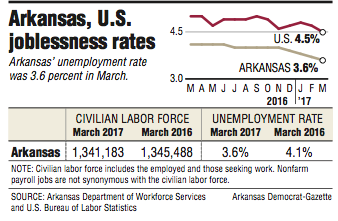Arkansas' unemployment rate dropped to 3.6 percent in March, its third-straight monthly record low, the U.S. Bureau of Labor Statistics said Friday.
The national unemployment rate was 4.5 percent in March.
The state's unemployment rate was 3.7 percent in February and 3.8 percent in January.
Since 1957, as far back as data are available, Arkansas' unemployment rate has not been as low as 3.8 percent until this year, according to the bureau.
Unemployment data were published only in annual reports to the president from 1957 to 1975, and those reports included only annual unemployment rates for the states, a spokesman with the bureau said. From 1976 to the present, the bureau has reported monthly rates for each state, the spokesman said.
Among the states, Arkansas is in a tie for 13th for lowest unemployment rate.
The number of unemployed Arkansans in March was 48,609, the second-straight month the number fell below 50,000 and the lowest level in the state since records were kept beginning in 1976.
"The low unemployment rate reflects that what's happening in the national economy is going on at the state level, also," said Mervin Jebaraj, interim director of the Center for Business and Economic Research at the University of Arkansas, Fayetteville. "You see it in corresponding statistics, too. Consumer confidence is at an all-time high. A lot of economic indicators are positive as well."
There was improvement in Arkansas' labor force, which increased by almost 3,200 to 1,341,183 from February to March, said Michael Pakko, chief economist at the Institute for Economic Advancement at the University of Arkansas at Little Rock. The labor force includes the employed and those seeking work.
There were 4,400 more Arkansans employed in March, compared with February.
"So we're seeing improvement in employment growth and a decline in the unemployment rate simultaneously," Pakko said.
The low unemployment rate doesn't necessarily imply that the state has a tight labor market, said John Shelnutt, the administrator for economic analysis and tax research for the state's Department of Finance and Administration.
If those working part time and the discouraged Arkansans who didn't seek work are included, the state's unemployment rate is above 7 percent, Shelnutt said.
"We still have room to bring people up from part time to full time," Shelnutt said.
Low unemployment rates should eventually lead to wage increases, some economists say.
"We have seen modest increase in wages in Arkansas recently, unlike in the past 10 years," Jebaraj said.
Washington County is one of the top 10 counties in the country in terms of wage increases over the past year, Jebaraj said.
Salaries started rising last year for accounting and finance personnel, said Stephanie Shine, director of permanent placement services for Robert Half Finance and Accounting.
Shine, who works in Robert Half's Little Rock office, recruits candidates who would be full-time employees for existing businesses.
"When we have an initial conversation with a client and they say they want a controller for $50,000, we tell them you can't get a controller for that," said Shine, who recruits throughout Arkansas. "You might get a non-degreed bookkeeper for that now."
Typical salaries in Arkansas for a bookkeeper or payroll employee without a college degree is $35,000 to $45,000, Shine said. The salary for a staff accountant with an accounting degree starts at $45,000 and a controller to a chief financial officer is paid at least $80,000 to $100,000, she said.
The unemployment rate nationally in the accounting and finance field is 1 percent to 1.5 percent, Shine said, so finding candidates for clients seeking to hire is not simple.
"Clients are having trouble finding [employees] and they're posting ads, but that's not working," Shine said. "We're not getting talent with our ads, either. So we're heavily involved in networking, community service. We have more openings than we have candidates."
Seven of Arkansas' industry sectors saw job increases since March 2016 and four saw declines.
The educational and health services sector had the largest gain of jobs with 7,000. The professional and business services sector had 5,800 additional jobs in the past year. The manufacturing sector, which has lost more than 35,000 jobs in the past 10 years, added 2,600 jobs since March last year, the third-highest increase in the state.
"That's an encouraging sign," Pakko said. "That's an indication of a long-awaited improvement in manufacturing employment."
The big chunk of growth came in nondurable goods, most likely in food processing, Pakko said.
Overall, nonfarm payroll jobs increased by 16,600 since March last year. More than 12,000 of those jobs were in the Northwest Arkansas and Little Rock metropolitan areas, indicating that rural areas of the state continue to struggle, Jebaraj said.
Colorado had the lowest unemployment rate at 2.6 percent, followed by Hawaii at 2.7 percent and New Hampshire, North Dakota and South Dakota at 2.8 percent each.
New Mexico had the highest unemployment rate at 6.7 percent, followed by Alaska at 6.4 percent, Alabama at 5.8 percent, Louisiana at 5.7 percent and Georgia at 5.1 percent.
A Section on 04/22/2017

